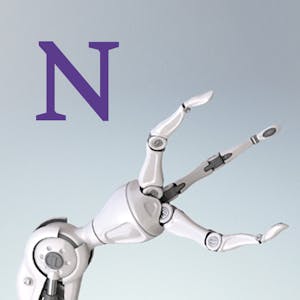Modern Robotics, Course 2: Robot Kinematics
About this Course
Do you want to know how robots work? Are you interested in robotics as a career? Are you willing to invest the effort to learn fundamental mathematical modeling techniques that are used in all subfields of robotics? If so, then the \"Modern Robotics: Mechanics, Planning, and Control\" specialization may be for you. This specialization, consisting of six short courses, is serious preparation for serious students who hope to work in the field of robotics or to undertake advanced study. It is not a sampler. In Course 2 of the specialization, Robot Kinematics, you will learn to solve the forward kinematics (calculating the configuration of the \"hand\" of the robot based on the joint values) using the product-of-exponentials formula. Your efforts in Course 1 pay off handsomely, as forward kinematics is a breeze with the tools you\'ve learned. This is followed by velocity kinematics and statics relating joint velocities and forces/torques to end-effector twists and wrenches, inverse kinematics (calculating joint values that achieve a desired \"hand\" configuration), and kinematics of robots with closed chains. This course follows the textbook \"Modern Robotics: Mechanics, Planning, and Control\" (Lynch and Park, Cambridge University Press 2017). You can purchase the book or use the free preprint pdf. You will build on a library of robotics software in the language of your choice (among Python, Mathematica, and MATLAB) and use the free cross-platform robot simulator V-REP, which allows you to work with state-of-the-art robots in the comfort of your own home and with zero financial investment.Created by: Northwestern University

Related Online Courses
How do planes take off? How do they fly? How do pilots maintain control of them? And how high can airplanes fly? Get answers to all these questions and more with this specialization exploring the... more
The objective of this course is to provide an overview of the culture of ancient Rome beginning about 1000 BCE and ending with the so-called \"Fall of Rome\". We will look at some of the key people... more
By the end of this project, you will have created a Visual Tasks Guide to use with your students. As teachers, we are always looking for ways to help our students grow. For students with special... more
\"GenAI for Data Analysts\" explores the revolutionary impact of Generative AI on data analysis. This course offers a comprehensive introduction to GenAI\'s capabilities and practical strategies... more
This specialization is designed for post-graduate students interested in mastering social computing techniques to solve real-world problems. Through four in-depth courses, learners will explore key... more








